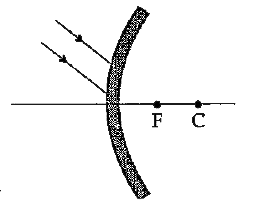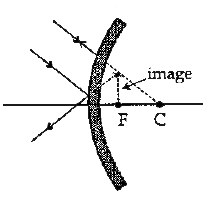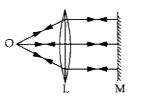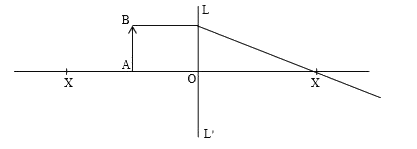Complete the ray diagram as shown to show the formation of image for parallel rays incident on a convex mirror. State the position, nature and size of the image formed.

The completed ray diagram is shown. The image is formed at the focus F (behind the mirror). It is virtual, erect and diminished.

Topper's Solved these Questions
- BOOK - ICSECHAPTER - LIGHTEXERCISE - TOPIC 2 Spherical Mirrors (3 Marks Questions )21videos
LIGHT
- BOOK - ICSECHAPTER - LIGHTEXERCISE - TOPIC 2 Spherical Mirrors (4 Marks Questions )9videos
LIGHT
- BOOK - ICSECHAPTER - LIGHTEXERCISE - TOPIC 1 Reflections of Light (4 Marks Questions )10videos
LIGHT
- BOOK - ICSECHAPTER - LAWS OF MOTIONEXERCISE - EXERCISE - 3(E) (Numericals)31videos
LAWS OF MOTION
- BOOK - ICSECHAPTER - MAGNETISM EXERCISE - EXERCISE-10(B) (Multiple Choice Type)2videos
MAGNETISM
Similar Questions
Knowledge Check
- Question 1 - Select One
The image formed by a convex mirror is
Aerect and diminishedBerect and enlargedCinverted and diminishedDinverted and enlarged.
Draw a diagram to show the reflection of a light ray incident normally on a plane mirror.
View SolutionDraw a ray diagram showing the formation of image of a point object by a plane mirror.
View SolutionWhat is the nature of the image formed by a convex mirror?
View SolutionDraw a ray diagram to show the formation of image by a concave mirror for an object beyond its centre of curvature. State three characteristics of the image.
View SolutionNature of image of a real object formed by convex mirror is always
View SolutionDraw a ray diagram to show the formation of image by a concave mirror for an object placed between its pole and focus. State three characteristics of the image.
 View Solution
View SolutionThe given ray diagram illustrates the experimental set up for the determination of the focal length of a converging lens using a plane mirror.

state the magnification of the image formed .View Solution



